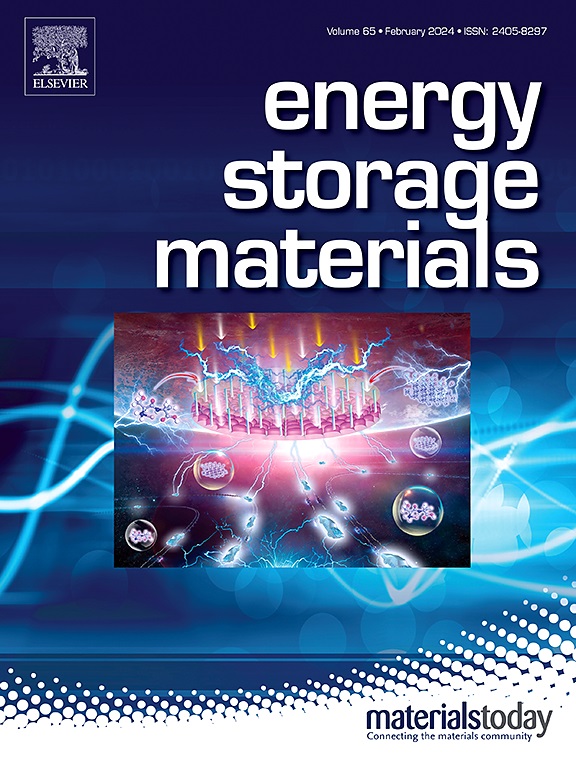钙离子介导的超低温锌离子水电池防冻电解质的通用策略
IF 20.2
1区 材料科学
Q1 CHEMISTRY, PHYSICAL
引用次数: 0
摘要
水锌离子电池(azib)因其高安全性、环保性和低成本而被认为是一种很有前途的储能材料。然而,在极端寒冷环境下的操作仍然是应用的关键挑战。本文提出了一种利用Ca2+调节氢键(HB)网络和溶剂化结构的抗冻电解质通用设计策略。添加了CaCl2的Zn(ClO4)2电解质具有极低的冰点(-60.66℃)和较高的离子电导率(-60℃时为1.79 mS cm-1)。分子动力学模拟表明,Ca2+诱导了HBs和竞争性水化的调节,使Zn2+配位数从5.75降低到4.69。该优化降低了快速反应动力学的能量障碍,实现了长期循环稳定性(Zn||Zn >1100 h),高库仑效率(Zn||Cu在600次循环中99.61%),以及在-60°C下满电池350次循环后的70.62%的容量保持率。值得注意的是,该策略适用于各种体系,如Zn(ClO4)2、Zn(BF4)2、ZnCl2和Zn(OTf)2,这些体系的凝固点下降超过40°C,并且在-55°C下都能实现长期使用。期望我们的工作为超低温储能提供一个通用的框架。本文章由计算机程序翻译,如有差异,请以英文原文为准。


Universal strategy of Ca2+-mediated antifreeze electrolyte for ultralow-temperature aqueous Zinc-Ion batteries
Aqueous zinc-ion batteries (AZIBs) are considered as the promising candidate for energy storage due to high safety, eco-friendliness, and low-cost. However, the operation in extreme cold environments remains a critical challenge for applications. Herein we propose a universal design strategy of anti-freezing electrolyte using Ca2+ mediation for regulating hydrogen bond (HB) network and solvation structure. The Zn(ClO4)2 electrolyte with CaCl2 additive achieves an ultralow freezing point (-60.66 °C) and high ionic conductivity (1.79 mS cm-1 at -60 °C). Molecular dynamics simulations reveal the Ca2+-induced the regulation of HBs and competitive hydration, which reduces Zn2+coordination numbers from 5.75 to 4.69. This optimization lowers energy barriers for rapid reaction kinetics, enabling long-term cycling stability (>1100 h for Zn||Zn), high Coulombic efficiency (99.61 % over 600 cycles for Zn||Cu), and 70.62 % capacity retention after 350 cycles in full cells at -60 °C. Remarkably, this strategy is applicable to various systems such as Zn(ClO4)2, Zn(BF4)2, ZnCl2, and Zn(OTf)2, where freezing points drops >40 °C and all achieve long-term lifespan at -55 °C. It is expected that our work provides a universal framework for ultralow-temperature energy storage.
求助全文
通过发布文献求助,成功后即可免费获取论文全文。
去求助
来源期刊

Energy Storage Materials
Materials Science-General Materials Science
CiteScore
33.00
自引率
5.90%
发文量
652
审稿时长
27 days
期刊介绍:
Energy Storage Materials is a global interdisciplinary journal dedicated to sharing scientific and technological advancements in materials and devices for advanced energy storage and related energy conversion, such as in metal-O2 batteries. The journal features comprehensive research articles, including full papers and short communications, as well as authoritative feature articles and reviews by leading experts in the field.
Energy Storage Materials covers a wide range of topics, including the synthesis, fabrication, structure, properties, performance, and technological applications of energy storage materials. Additionally, the journal explores strategies, policies, and developments in the field of energy storage materials and devices for sustainable energy.
Published papers are selected based on their scientific and technological significance, their ability to provide valuable new knowledge, and their relevance to the international research community.
 求助内容:
求助内容: 应助结果提醒方式:
应助结果提醒方式:


